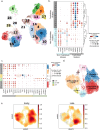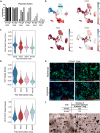This is a preprint.
Single-cell transcriptomics reveal differences between chorionic and basal plate cytotrophoblasts and trophoblast stem cells
- PMID: 40585209
- PMCID: PMC12204482
- DOI: 10.21203/rs.3.rs-6797967/v1
Single-cell transcriptomics reveal differences between chorionic and basal plate cytotrophoblasts and trophoblast stem cells
Abstract
Cytotrophoblast (CTB) of the early gestation human placenta are bipotent progenitor epithelial cells, which can differentiate into invasive extravillous trophoblast (EVT) and multinucleated syncytiotrophoblast (STB). Trophoblast stem cells (TSC), derived from early first trimester placentae, have also been shown to be bipotential; however, their cell-of-origin has not been identified. In this study, we set out to probe the transcriptional diversity of early and late first trimester villous CTB (vCTB) and compare these to TSC. To this end, we performed single-cell RNA sequencing (scRNA-seq) on placental villous tissue from early (6-8 weeks) and late (12-14 weeks) first trimester placentae; we also evaluated CTB within basal (maternal) and chorionic (fetal) regions of early first trimester placenta, both by scRNA-seq and GeoMx-based spatial transcriptomics. Finally, we performed scRNA-seq on three TSC lines, derived from 6-8 week gestation placentae, as well as on early first trimester CTB at several timepoints during TSC derivation. We found notable distinctions within CTB clusters based on gestational age, further influenced by location near the basal or chorionic plates. We identified trophoblast states representing "initial state" vCTB (in vivo CTB progenitors), as well as additional CTB subtypes, precursor STB, and precursor and mature EVT. CTB progenitors were enriched in early first trimester placentae at the basal plate; overall, basal plate CTB were biased toward EVT, and chorionic plate CTB toward STB, precursors. Clustering and trajectory inference analysis indicated that TSC were most like EVT precursor cells. In fact, vCTB lost their in vivo "initial state" markers, including PAGE4, as they transitioned to TSC during in vitro culture. This was confirmed by flow cytometric analysis of 6 different TSC lines, which showed uniform expression of proximal column markers ITGA2 and ITGA5. Additionally, we found that ITGA5+ CTB could be plated in 2D, forming only EVT upon spontaneous differentiation, but failed to form self-renewing organoids; conversely, ITGA5- CTB could not be plated in 2D, but readily formed organoids. Our findings suggest that distinct CTB states exist in different regions of the placenta as early as six weeks gestation and that current TSC lines most closely resemble ITGA5+ CTB, biased toward the EVT lineage.
Keywords: Cytotrophoblast; Placenta; Trophoblast; Trophoblast stem cells.
Conflict of interest statement
Declaration of interests The authors declare no competing interests.
Figures





Similar articles
-
Single-cell transcriptomics reveal differences between chorionic and basal plate cytotrophoblasts and trophoblast stem cells.bioRxiv [Preprint]. 2024 Jul 16:2024.07.12.603155. doi: 10.1101/2024.07.12.603155. bioRxiv. 2024. PMID: 39071344 Free PMC article. Preprint.
-
Stem cell insights into human trophoblast lineage differentiation.Hum Reprod Update. 2016 Dec;23(1):77-103. doi: 10.1093/humupd/dmw026. Epub 2016 Sep 2. Hum Reprod Update. 2016. PMID: 27591247
-
Amniocentesis and chorionic villus sampling for prenatal diagnosis.Cochrane Database Syst Rev. 2017 Sep 4;9(9):CD003252. doi: 10.1002/14651858.CD003252.pub2. Cochrane Database Syst Rev. 2017. PMID: 28869276 Free PMC article.
-
First trimester ultrasound tests alone or in combination with first trimester serum tests for Down's syndrome screening.Cochrane Database Syst Rev. 2017 Mar 15;3(3):CD012600. doi: 10.1002/14651858.CD012600. Cochrane Database Syst Rev. 2017. PMID: 28295158 Free PMC article.
-
Maternal and neonatal outcomes of elective induction of labor.Evid Rep Technol Assess (Full Rep). 2009 Mar;(176):1-257. Evid Rep Technol Assess (Full Rep). 2009. PMID: 19408970 Free PMC article.
References
-
- Turco M. Y. & Moffett A. Development of the human placenta. Development 146 (2019). - PubMed
Publication types
Grants and funding
LinkOut - more resources
Full Text Sources
Miscellaneous

